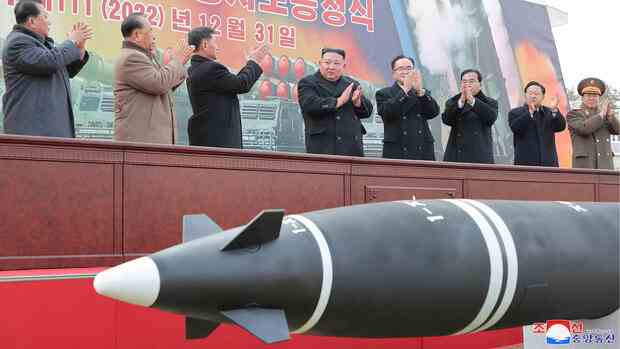Why hunger is a constant companion for many North Koreans
He ordered irrigation systems to be improved, more farm machinery to be built, and more arable land to be created. He named the country’s self-sufficiency as a long-term goal. But North Korea is still a long way from that. Bernhard Seliger, head of the office of the Hanns Seidel Foundation of the Christian Social Union in Korea, was repeatedly confronted with it during his stays in North Korea: “North Koreans have been suffering from malnutrition for decades,” he says.
North Korea’s rulers, here in a greenhouse, want to increase agricultural productivity.
(Photo: via REUTERS)
A series of surveys by the World Food Program of the United Nations shows how the supply situation initially improved significantly under ruler Kim, only to then deteriorate again even before the corona crisis. In 2018, only one percent of those surveyed described the supply as poor, in 2019 it was already eleven percent, and in 2021 even 71 percent.
>> Read here: Is there a nuclear arms race between North Korea and South Korea?
The trigger for the deterioration was North Korea’s nuclear test in 2017. As a result, the United Nations tightened sanctions against the country, which was later reflected in the 2019 slump in imports. This brought North Korea’s problems back to the fore: pre-industrial agriculture and the state economy.
Seliger experienced it herself on a state farm that the Hanns Seidel Foundation looked after as part of a project. “They had 400 to 500 hectares of land, 165 draft oxen and a tractor,” he recalls. In addition, agriculture is collectivized – in production cooperatives and state-owned companies. The incentive to increase earnings is therefore low.
Sanctions and Covid-19 exacerbated the situation
According to South Korean estimates, North Korea’s rice production is between 4.4 and 4.8 million tons per year, while 5.5 million tons would be needed to feed the 26 million North Koreans.
At the same time, the North Koreans have problems maintaining their acreage. According to statistics, in 2022 the area under cultivation shrank by 0.8 percent. To make matters worse, North Korea, unlike other countries, has few opportunities to buy the missing calories from food on the world market. Because the foreign exchange has been missing since the sanctions. And Kim would rather develop missiles and nuclear weapons at full speed than give in to international pressure and disarm with nuclear weapons.
At the moment, the main thing that remains is the help of the protecting power China, which has so far covered around half of the rice shortage through exports. But during the pandemic, inflow from this source also fell because North Korea largely sealed off the border with China for fear of Covid-19. Imports have only been increasing again since autumn 2022. According to the Chinese customs authorities, in December they were 30,000 tons. Russia also exported grain.
North Korea’s agriculture is considered extremely inefficient.
(Photo: dpa)
According to Lucas Rengifo-Keller from the American Peterson Institute for International Economics, the situation is critical. According to his analysis, the availability of food is “the worst it has been since the famine in the 1990s”.
He doesn’t trust the UN system’s estimates that there have only been famines in North Korea in two of the past 27 years. However, his own analysis shows that “from the 2020/21 harvest, the food supply will probably no longer be sufficient to meet minimal human needs”.
Other experts see no signs of a humanitarian catastrophe. Seliger: “I believe that we are dealing with hunger rather than famine.” In addition, the North Koreans are now better prepared for bottlenecks. A problem in the 1990s was the collapse of the central state supply system.
Tentative privatizations in agriculture
In the meantime, it is tolerated that farmers grow privately on steep mountain slopes and sell the products privately. In addition, state-owned companies and ministries have established their own farms.
Chad O’Charrol, founder of the analysis service NK News, also judges: “There is nothing unusual at the moment.” The rice prices have risen in the past two to three weeks. However, this is combined with a government call for a “patriotic rice donation” from the subjects to the military. In addition, the North Korea observer sees no signs that more people want to flee the north.
O’Charrol therefore believes it is likely that parts of North Korean society are still suffering from acute food shortages and people are starving. However, he doubts reports in South Korea about starvation deaths in the North Korean industrial region of Kaesong. “Until proven otherwise, I am skeptical that dozens of people die every day in Kaesong – right on the border.”
More: How North Korea’s state hackers are stealing billions of dollars in cryptocurrencies
